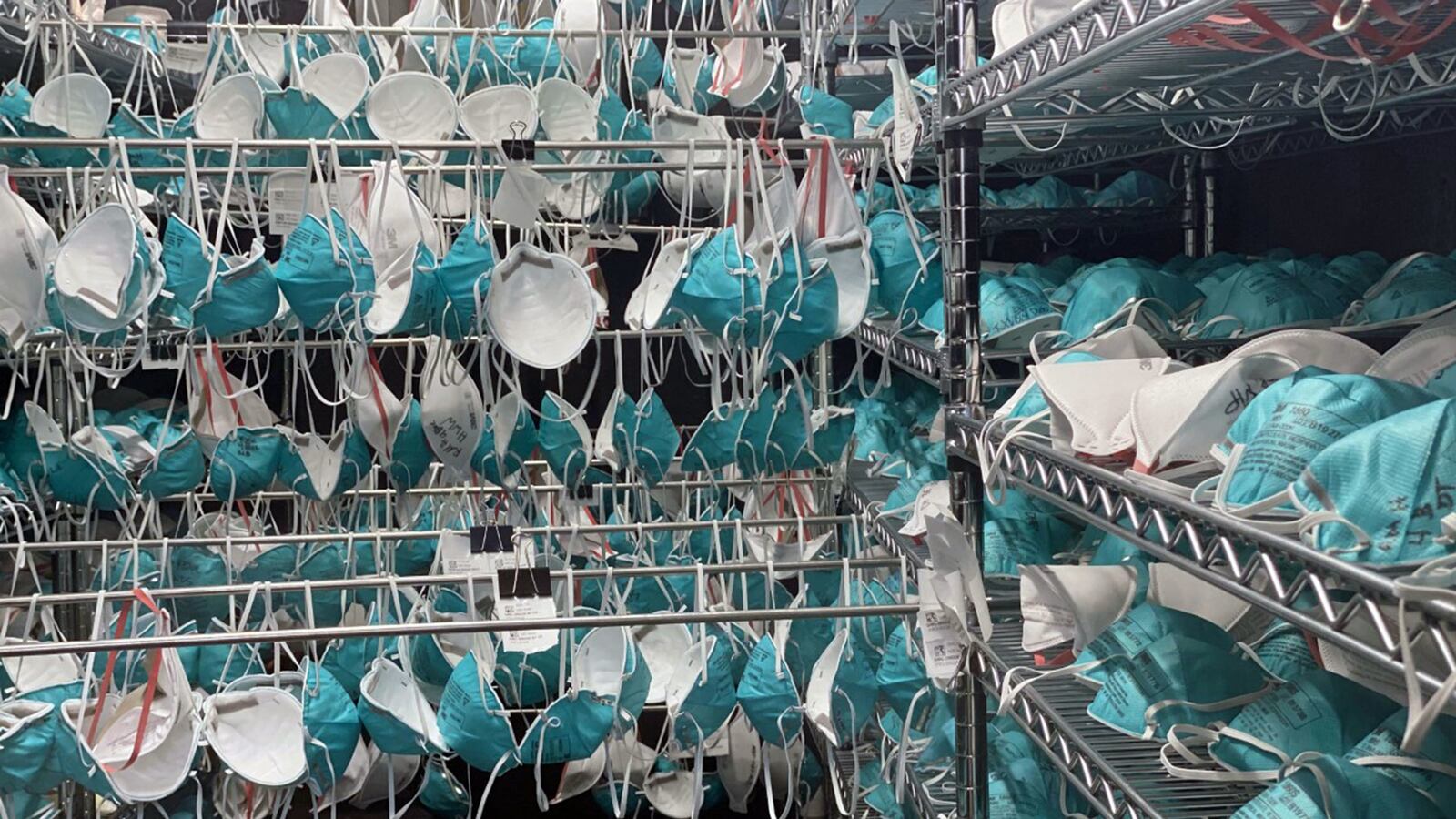The health-care workers on the front lines of the fight against COVID-19 are pleading for more masks and protective gear to save them from the virus. Companies are cranking up production but there’s still not enough to go around yet.
Fortunately, researchers in Ohio and Nebraska have come up with new ways to let doctors and nurses safely reuse the gear they have with new disinfection procedures. One uses a vapor form of hydrogen peroxide to kill any lingering COVID-19, and another bathes them in virus-frying ultraviolet radiation. So how do these systems work and how many masks can they clean up?
Welcome to Rabbit Hole, where we dive deep on the biggest story. It’s for Beast Inside members only. Join up today.
Ultraviolet COVID killers: Dr. John Lowe is part of a team of researchers at the University of Nebraska Medical Center who’ve developed a process for using UV light on N95 respirators.
It turns out the same kind of light from the sun or tanning beds that doctors warn you to avoid is just as damaging to COVID-19 as it is to you.
“Just like UV light isn’t great for our skin—it can cause skin cancer and sunburns—UV light damages cells to the point where cells can die,” Lowe explained in an interview released by the University of Nebraska Medical Center. “In the case of the virus, the UV light disrupts the RNA of the virus and inactivates the virus so it can’t infect anyone else.”
Scientists divide ultraviolet light into three types—UV-A, UV-B, and UV-C—based on their wavelengths. UV-C has the shortest wavelengths of all three, spanning between 100 and 280 nanometers, and it’s the most damaging to cells of all three, which makes it a prime candidate for disinfecting procedures.
The process developed by Nebraska Medical turns a room into something like a microwave for UV-C radiation. Researchers coat a room in reflective material to make sure the UV-C light can be widely distributed, and two powerful UV-C TORCH towers made by commercial manufacturer ClorDiSys are placed at either end of the room while the masks hang from wires like an old-fashioned laundry line. One cycle lasts just a few minutes before workers re-enter the room, bag up the masks, and ship them back to their owners.
“Our health-care workers are saving the masks after they use them and sending them to a central processing where we’re using UV light to disinfect those masks,” said Lowe.
The downside to the UV approach is that it’s more destructive to the N95 masks. Researchers estimate that they can only do about three to five cycles of UV decontamination before it starts to affect the fit of masks—too much time under the light can start to degrade the material in mask straps.
The UV-C method adapts proven methods with commercial equipment used in the health-care industry for years to the problem of COVID-19-driven personal protective equipment shortages. Scientists first started researching the effect of UV light on bacteria in the late 19th century with important studies by Dr. Frederick L. Gates that pinpointed the best wavelength for targeting the genetic material of bacteria.
In the decades since that early research, hospitals and health-care facilities have installed air filters equipped with UV-C bulbs as additional measures to help kill bacteria and reduce the risk of infection from diseases like tuberculosis.
Vaporwave: In Ohio, researchers at the Battelle Memorial Institute, a nonprofit research group, have built on their existing research in personal protective equipment (PPE) disinfection to develop the Critical Care Decontamination System.
When health-care workers and hospitals in the OhioHealth network, a statewide health-care nonprofit, are done using a mask, they mark it with a code, package it up in plastic, and ship it out to Battelle for decontamination.
Once Battelle receives the gear, workers hang the N95 masks on racks and put them into 20-foot metal chambers. When the racks are full, the doors are closed and a generator pumps hydrogen peroxide vapor in for two and a half hours, making the chamber a kind of decontamination sauna for the masks.
Hydrogen peroxide, a key ingredient in a range of disinfectants like hand sanitizer, is effective at killing everything from bacteria from viruses, and when turned into a vapor in a confined space surrounds and permeates the masks. Battelle researchers say the method is effective at killing anything from anthrax to COVID-19 that might appear on the masks. In fact, hydrogen peroxide vapor was used to help decontaminate the Hart Senate office building and Washington, D.C.-area mail facilities after the 2001 anthrax attacks.
Easy on your delicates: The vapor isn’t just good at killing pathogens, it’s also easy on the equipment. In a previous study, Battelle researchers found that the vapor “did not degrade the performance of the aerosol filtration media” in the model of N95 masks they tested. The straps alongside the masks experienced did suffer some degradation after going through 30 repeated cycles of the machines.
But that’s not as big a problem as it may seem. The FDA says that respirators are safe to undergo up to 20 cycles through the Battelle system, meaning that individual masks aren’t going to see the same amount of exposure that caused degradation in previous tests.
Scaling up: When the outbreak first took place, Battelle began decontaminating masks with its system at a rate of about 1,000 pieces of PPE per cycle. Following a public plea from Ohio Gov. Mike DeWine, the FDA allowed Battelle to increase its rate to 10,000 pieces of equipment a day. Right now, Battelle is decontaminating PPE for OhioHealth, but the organization plans to make more for national distribution, and one system is already en route to the New York metropolitan area to address shortages there.
Off the shelf: Battelle’s method is promising not just because prior research has shown it to be effective but because it relies in large part on equipment that’s already available commercially. At the heart of the system are commercial hydrogen peroxide generators. The devices can be small, luggage-sized mobile devices available for a few thousand dollars. They’re already used widely for decontamination purposes across the health-care industry, including for decontaminating operating rooms, research laboratories, and other sensitive areas.
The decontamination chambers themselves are standardized 20-foot CONEX box shipping containers, a common design around the world that has been in use since the Korean War. And of course hydrogen peroxide is a simple, cheap, and easily made and widely available commodity with a proven history in decontamination.
Origins: We’ve known for a while that a pandemic influenza could be coming and that it would cause a run on PPE. A 2009 interagency working group on respirators (dubbed “Project BREATHE”) recommended the FDA develop standards for cleansing and reusing face masks because “during a crisis in which respirators may be in short supply, respirators that are durable enough to be repeatedly reused may be necessary.”
It’s a recommendation that public health experts have been warning about for a long time.
Battelle researchers were able to spin up their industrial-strength PPE cleanser because their research on the subject had a head start of a few years. In 2016, Battelle researchers pointed to the threat of a pandemic influenza as a motivation for their report on the use of hydrogen peroxide vapor to decontaminate N95 masks. The authors cited a 2006 study by the National Academy of Sciences on the need for reusable respirators, which warned that “demand for N95 respirators by the healthcare sector could exceed 90 million for a 42-day outbreak.”






